Landscape of Caucasus Wildlife Refuge (H. Thiessen)
Birds in the Khosrov-Reserve and the Caucasus Wildlife Refuge (CWR),
List of Bird species seen between 20.05. to 30.05.2019
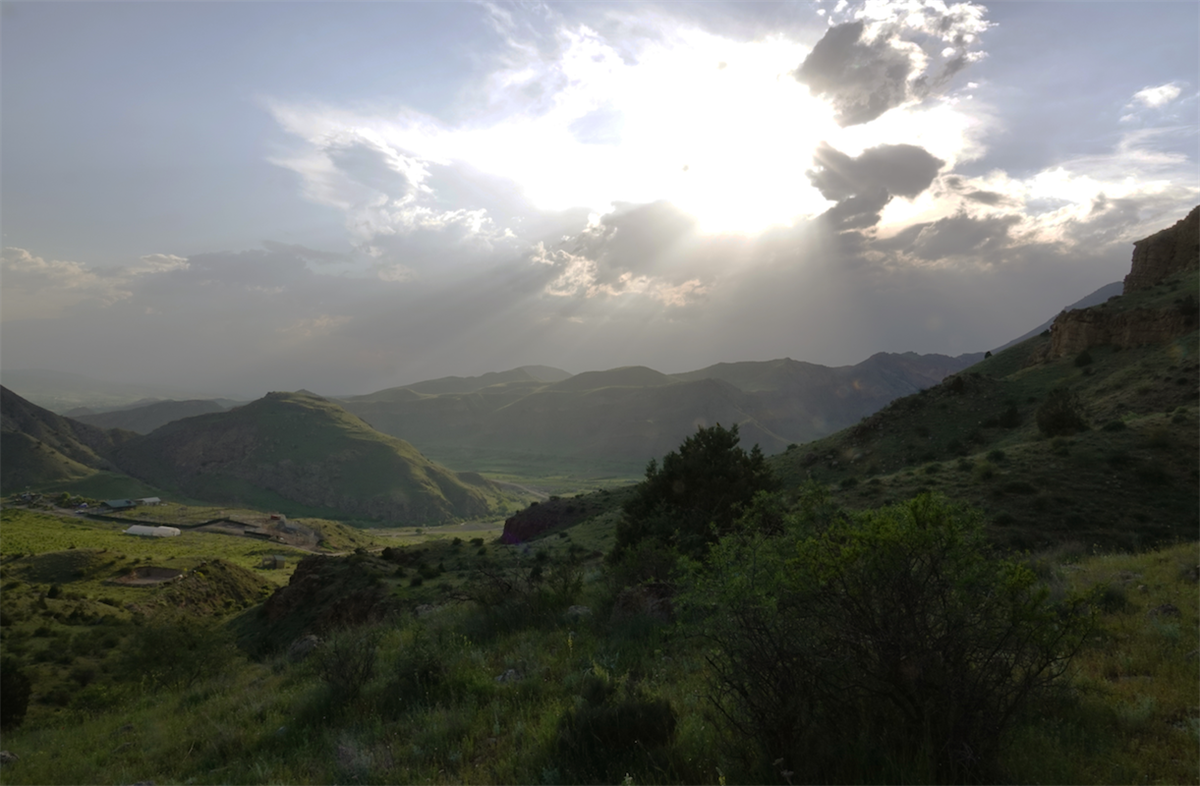
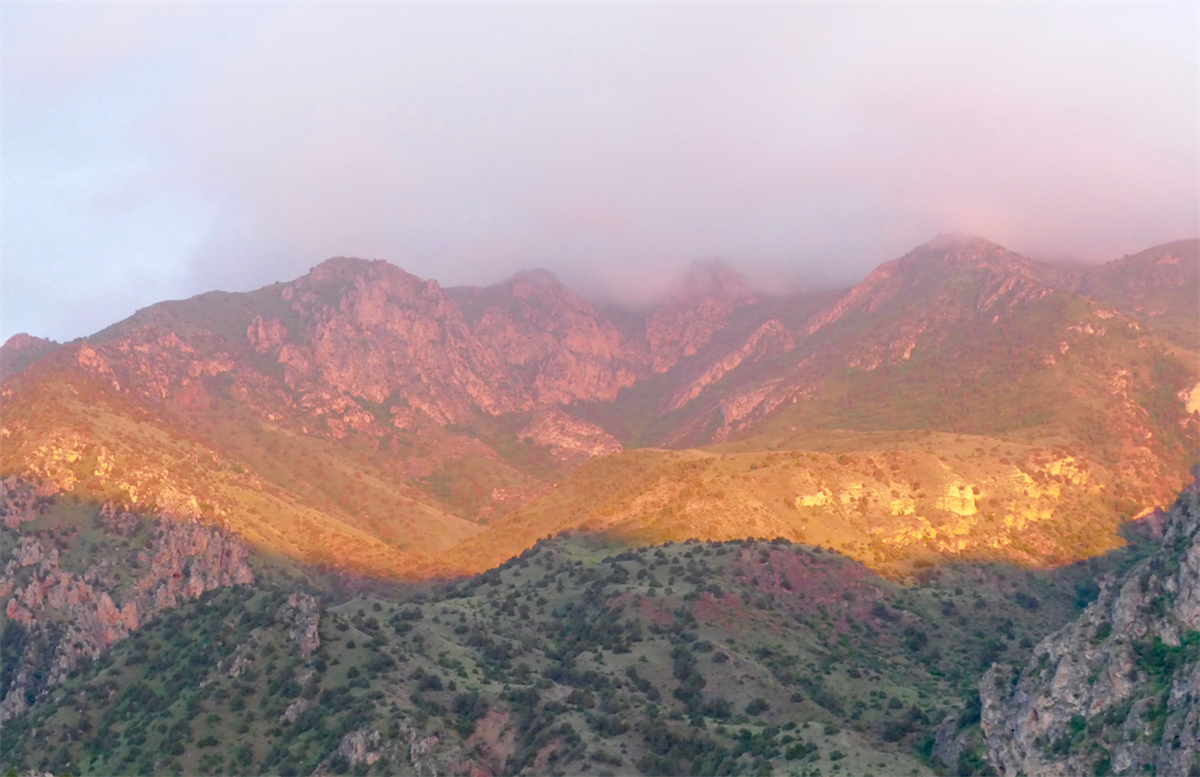
CWR in extreme light („Alpenglühen“; B. Koop)
Introduction
The Caucasus is known as a hot spot of biodiversity. This belongs also to the avifauna of the area. On the other hand there is little knowledge of the bird numbers especially of Armenia. In Heath & Evans (2000) there are population numbers of the Important Bird Areas (IBAs) published.
Five IBAs are decribed: Lake Arpi in the north (most important breeding site for Larus armenicus), Pombak Mountain Chain (alpine species), Khosrov-reserve (raptors), Armash fish farm (29 fish ponds, 2.745 hectares, Wetland species) and Lake Sevan (the second great breeding site for endemic Larus armenicus).
We focussed during our short tour on the Khosrov-Reservat and the Caucasus Wildlife Refuge (CWR). The species list contains some details on breeding density and vertical distribution as it is possible to confirm this during such a tour.
The landscape we visited is in overall grazed mountain landcape, naturally wooded, but extensive grazing led to semi-open steppe vegetation.
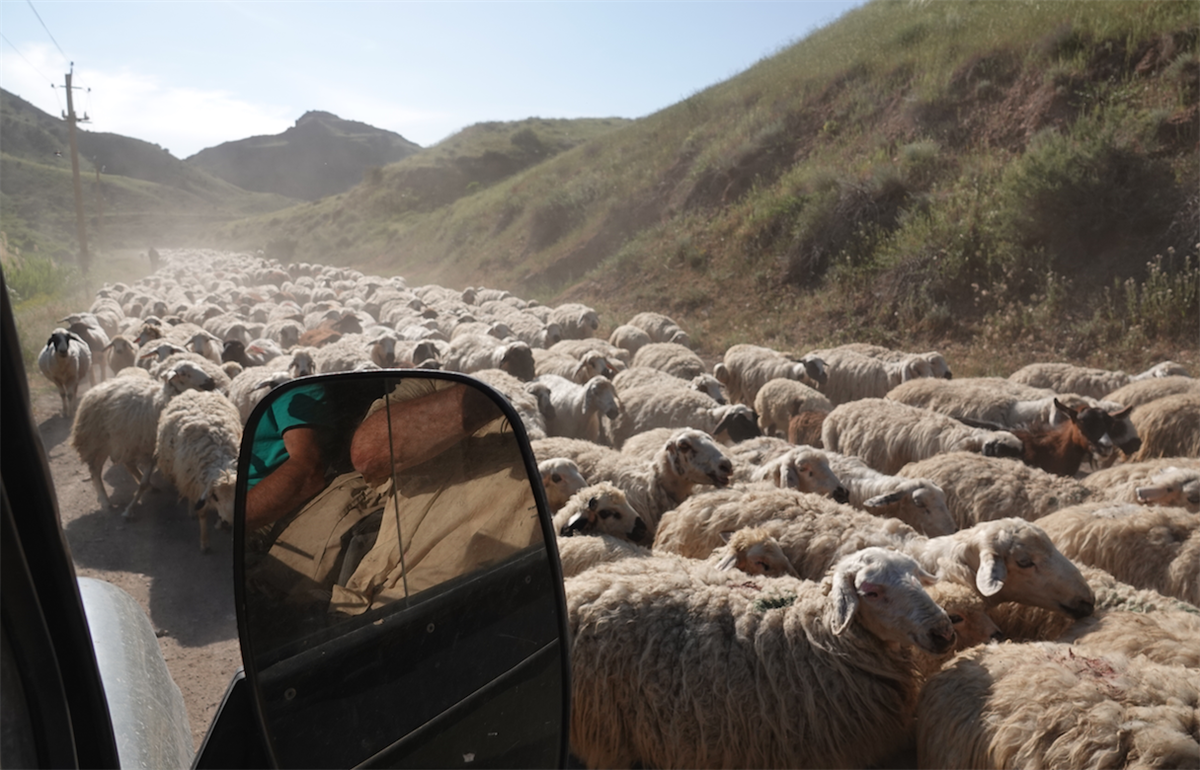
The landscape is used for Cattle and Sheep grazing (H. Thiessen)
Many thanks to Hartmut Roweck initiating and organizing the tour and also to Henning Thiessen for phantastic photographs of many bird species.
List of Bird species:
- Chukar, Alectoris chucar: Common in the open mountain vegetation. In the surrounding of the logde at least 20-25 pairs. Armenia is one of the strongholds for the species (Burfield & van Bommel 2004).
- Common Quail, Coturnix coturnix: Breeding species higher than 2.000 m in open alpine grassland, fairly common.
- Bearded Vulture, Gypaetus barbatus: In the CWR and the Khosrov-Reserve several pairs, we saw at least 5-6 adult birds individually different in moulting status, and 2-3 immatur birds. National population number was 4-10 pairs in the 1990ties (Burfield & van Bommel 2004).
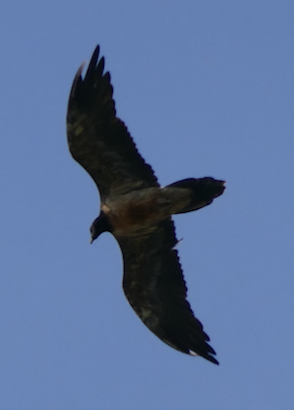
Immature Bearded Vulture (B. Koop)
- Griffon Vulture, Gyps fulvus: Breeding species in the CWR and the Khosrov-Reserve; 22.05. wie saw at least 23 Ind. feeding on a bigger carcass.
- Cinerous Vulture, Aegypius monachus: Breeding species; 22.05. wie saw at least 7 Ind. feeding on a bigger carcass together with Griffon Vultures. We only saw adult birds at several places. National population number was 8-15 pairs in the 1990ties (Burfield & van Bommel 2004).
Golden Eagle, Aquila chrysaetos: One pair breeding near the lodge in the CWR, the pair had 2 young chicks, in the End of May approx. 4 weeks old. Prey: Ophisaurus apodus (1); Alectoris chukar (1).
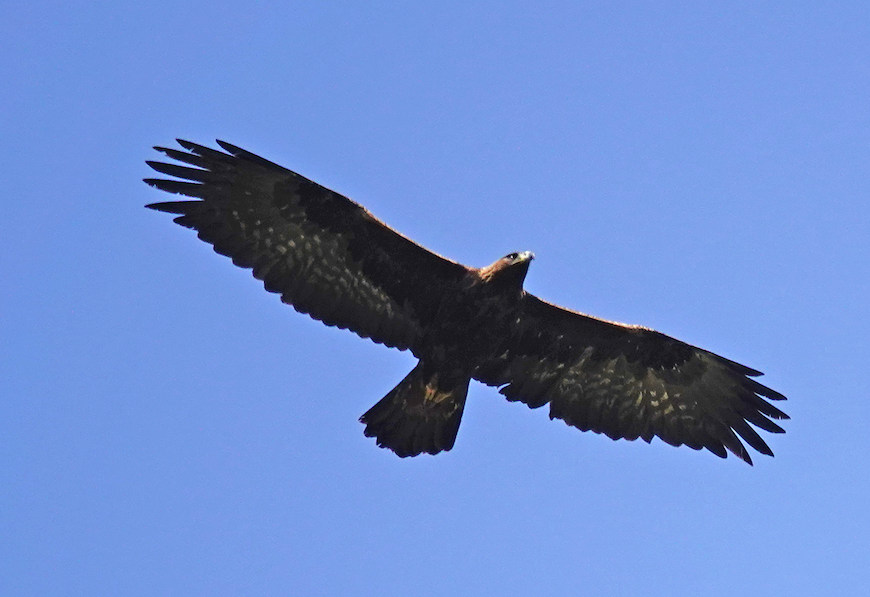
Adult Golden Eagle (H. Thiessen)
- Lesser Spotted Eagle, Aquila pomarina: 1 in Khosrov-Reserve 27.05., perhaps resident breeder?
- Booted Eagle, Aquila pennata: Several birds seen in the CWR: dark birds (1), light birds (3); Prey: Chukar (1).
- Short-toed Eagle, Circaetus gallicus: Breedings species? At several days perhaps always the same individual in the CWR area feeding on snakes.
- Black Kite, Milvus migrans: Perhaps breeding species: 3 times a flying adult bird.
- Marsh Harrier, Circus aeruginosus: Passage migrant in th area, but a common breeding species in the fish ponds near Artash.
- Long-legged Buzzard, Buteo rufinus: Breeding Species in the CWR, several sightings, even pairs of adult birds.
- Steppe Buzzard, Buteo vulpinus: Common in the Khosrov-Reserve wih several pairs, especially in more wooded areas in breeding density like Common Buzzard in Northern Germany.
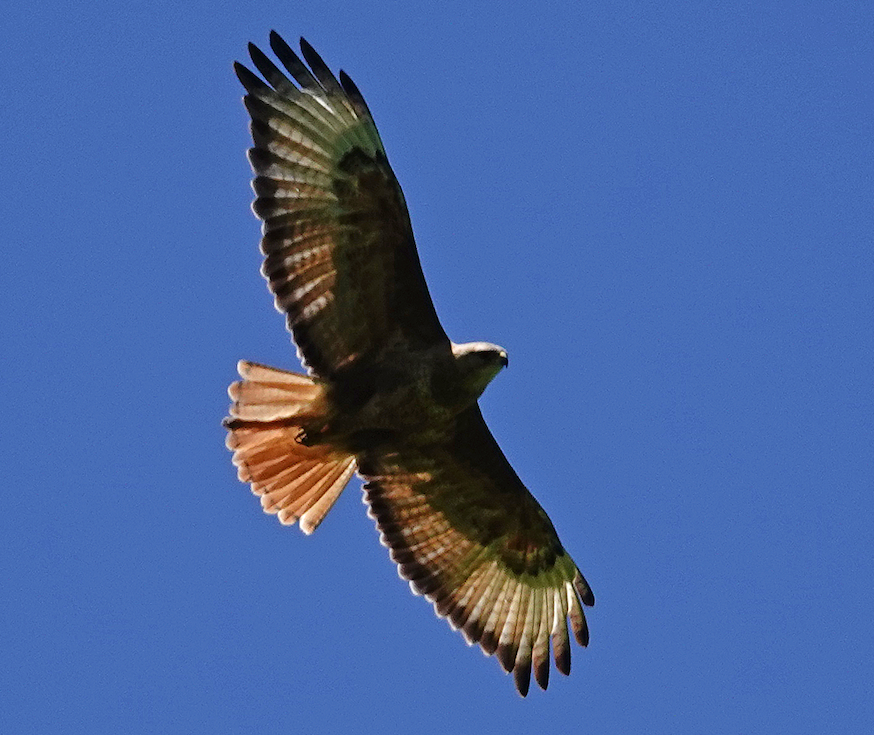
Adult Steppe Buzzard (H. Thiessen)
- Sparrowhawk, Accipiter nisus: One pair in the CWR, male hunting in the morning, female seen once.
- Goshawk, Accipiter gentilis: Only one bird 2. Cy. Perhaps in more wooded areas Breeding status in Armenia is unclear (Burfield & van Bommel 2004).
- Honey Buzzard, Pernis apivorus: 23.05. 3 migrating birds, in the CWR 3 sightings of perhaps breeding individuals, but no display flight or territorial behaviour seen.
- Kestrel, Falco tinnunculus: breeding species, 2-3 pairs in the CWR around the lodge, every day territorial interactions with Golden Eagles and Steppe Buzzards.
- Red-footed Falcon, Falco vespertinus: perhaps passage migrant: 1 male at CWR, Logde, 23.05.
- Hobby, Falco subbuteo: 24.05. 1 CWR
- Saker/Lanner, Falco cherrug/biarmicus: Perhaps breeding: 21.05. 1, 22.05. 1 with big prey flying east of the lodge. Another Saker/Lanner was fotographed near CWR, west of the lodge (H. Thiessen). A final decision for one of the two species is not possible, Lanner is said to b a rare breeder in the surrounding.
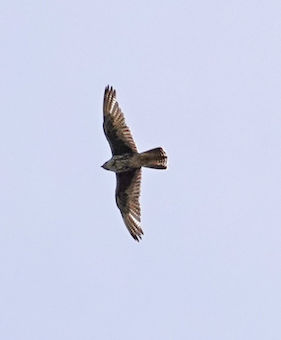
- Common Pigeon (Rock dove), Columba livia: Wild birds in Khosrov-Reserve.
- Stock dove, Columba oenas: Several flying birds near the Lodge, breeding possibilities in tree holes at River Vedi.
- Wood Pigeon, Columba palumbus: Wood species in higher altitudes, rather scarce.
- Turtle Dove, Streptopelia turtur: Breeding species in the cultivations, several pairs in the Vedi-valley with fields, Apricot yards and other cultivations. Quite rare in Armenia: 650-1.000 pairs (Burfield & van Bommel 2004).
- Cuckoo, Cuculus canorus: 2-3 males, several femals in the CWR area, quite common. Possible host species: White Wagtail.
- Eagle Owl, Bubo bubo: 25.05. 1 fresh feather was found near the Lodge. Species is breeding species in the CWR and Khosrov-Reserve.
- Scops Owl, Otus scops: 1-2 singing males in the Vedi-valley, where trees with holes are common.
- European Nightjar, Caprimulgus europaeus: Breeding species, 2-3 singing males arounde the lodge.
- Common Swift, Apus apus: Very common breeder in Urtzadzor, Vedi and Ararat with huge flocks, but also seen in the mountains, but no breeding colonie seen in cliffs. National population number was 100.000-150.000 pairs in the 1990ties (Burfield & van Bommel 2004).
- Alpine Swift, Apus melba: Only two sightings of single birds.
Hoopoe, Upupa epops: Rather common species of cultivations.
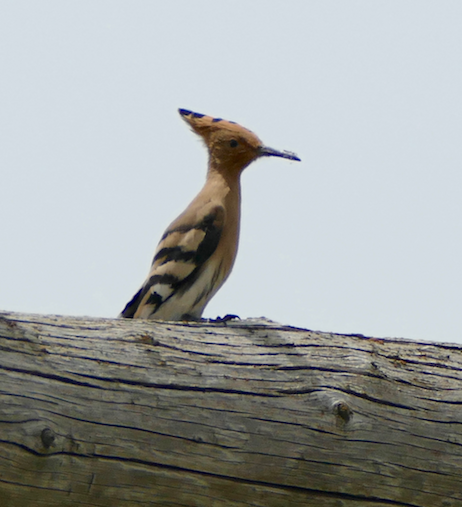
Hoopoe at the fish farm of Artash (B. Koop)
- European Bee-Eater, Merops apiaster: Seems to be common, in CWR some small sandy slopes, Feeding birds every day around the lodge.
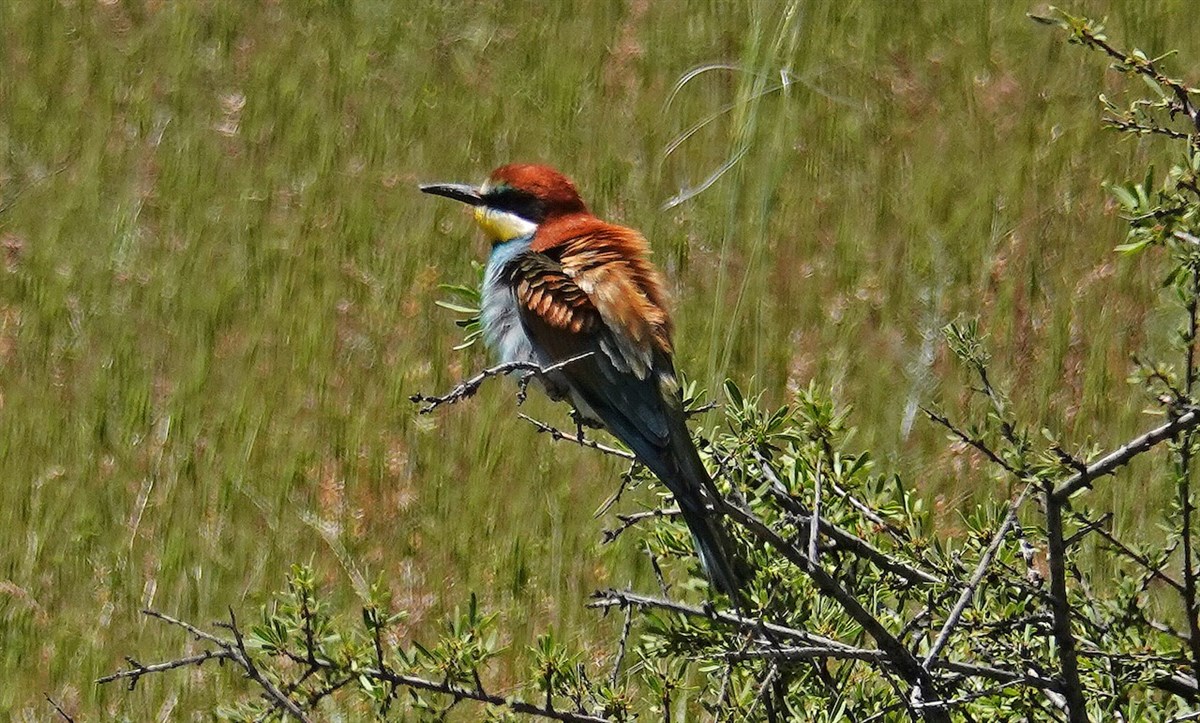
European Bee-eater (H. Thiessen)
- European Roller, Coracias garrulus: In the first week 2 birds stayed near the logde, in the second week perhaps start of breeding. Trees with holes in the Vedi-Valley, but the species also breeds in cliff holes.
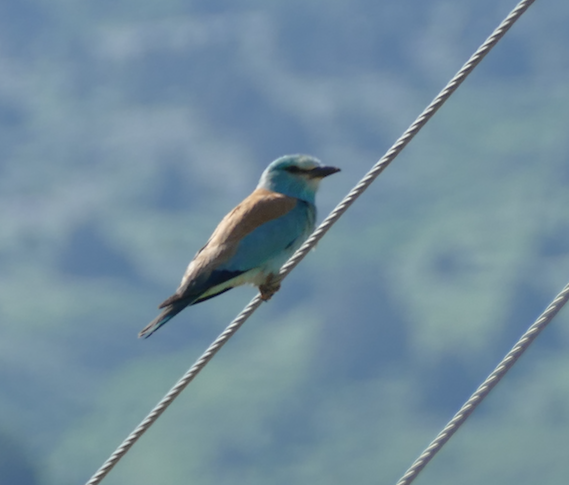
Eurasian Roller near the lodge in CWR (B. Koop)
- Common Woodpecker, Dendrocopos major: Scarce due to lack of woods. One drumming male in Khosrov-Reserve.
- Middle spotted Woodpecker, Dendrocopos medius: Woodland species, seen once in the Khosrov-Reserve.
- Skylark, Alauda arvensis: Species of alpine grassland above 2.000 m where it is common. Breeding densities like in dunes of Northern Germany.
- Crested Lark, Galerida cristata: Common in cultivations and grazed mountain areas with scarce bush. 3 pairs around the logde, young of one pair fledging at 29.05.
- Wood Lark, Lullula arborea: Fairly common in grazed mountains. 3 pairs in CWR around the logde: one with fledged youngs, 2 feeding pairs.
- Short-toed Lark, Calandrella brachydactyla: Scarce breeder in dry open areas.
- Sand Martin, Riparia riparia: In a sandy area near the town of Vedi a colonie of at least >100 pairs.
- Barn Swallow, Hirundo rustica: Common in villages and cultivations.
- House Martin, Delichon urbicum: Common in villages, in CWR only migrating birds.
- Eurasian Crag Martin, Ptyonoprogne rupestris: Species of rock habitats, nests on cliffs.
- Tawny Pipit, Anthus campestris: Scarce breeder in dry, open landscape in the CWR.
- Water Pipit, Anthus spinoletta: Common at alpine grassland at higher altitudes in the same habitats as Tree Pipit.
- Tree Pipit, Anthus trivialis: Common in higher altitudes in woodland, but also in alpine grassland with stones and cliffs. High density of territories like Birch mires in Northern Germany.
- White Wagtail, Motacilla alba: Common in cultivations, villages and human settlements. Most birds show more white in tertials than central European birds – typical for alba dukhunensis of Caucasian subspecies (Glutz von Blotzheim & Bauer 1985).
- Grey Wagtail, Motacilla cinerea: One pair at River Vedi in Khosrov-Reserve, perhaps more common.
- Dunnock, Prunella modularis: Common in wooded areas in higher altitudes.
- Robin, Erithracus rubecula: Common in wooded areas in higher altitudes.
Rufous-tailed Scrub Robin, Erythropygia galactotes: Seen twice in dry areas with scarce scrub vegetation. Scarce in Armenia: 800-3.300 pairs, Burfield & van Bommel (2004).
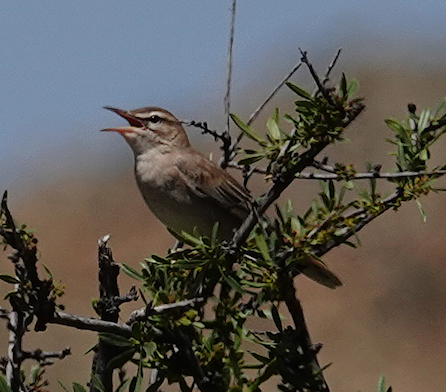
Rufous-tailed Scrub Robin (H. Thiessen)
- White-throated Robin, Irania guturalis: 3 territories in the CWR around the lodge in bushy habitat. At least two birds were paired after one week. In the last day of the tour songs occour less intensive. Armenia is a stronghold for this species (Burfield & van Bommel 2004).

White-Throated Robin (H. Thiessen)
- Northern Wheatear, Oenanthe oenanthe: Common in alpine grassland higher than 2.000 m.
- Isabelline Wheatear, Oenanthe isabellina. Very common in dryer, grazed habitats without bushes. Near Urtzadzor along the small road in south direction we count 1 male per 150 m, another track with 8 singing males per km.

Isabelline Wheatear (H. Thiessen)
- Eastern Black-eared Wheatear, Oenanthe melanoleuca: Scarce breeder in rocks with bushes in the CWR.
- Finch´s Wheatear, Oenanthe finschii: Common breeder in grazed mountain areas. In CWR 16 territories around the lodge, one pair in the Lodge garden. Following Burfield & van Bommel 2004 species is scarce in Armenia (1.300-1.600 pairs).
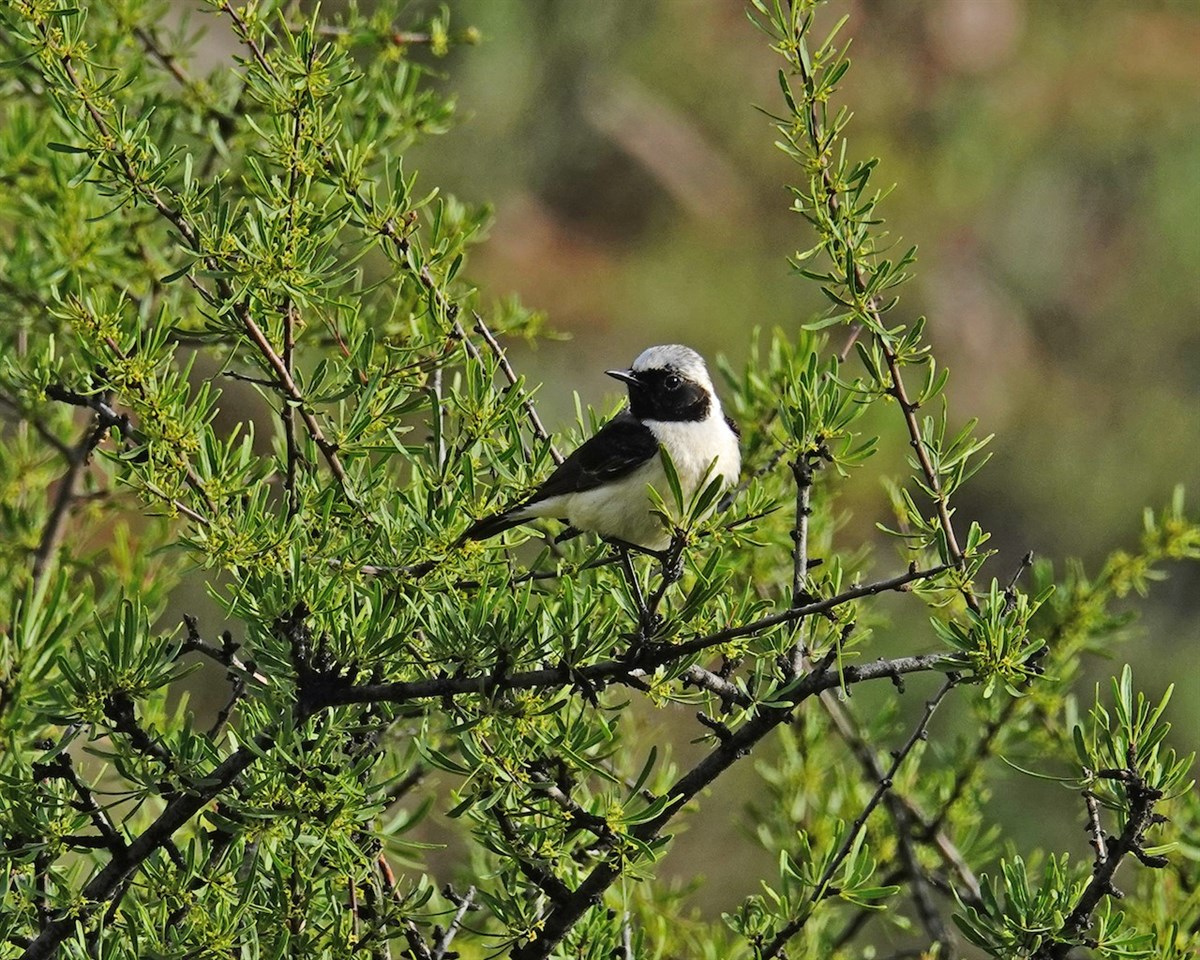
Finch´s Wheatear (H. Thiessen)
- Persian Wheatear, Oenanthe chrysopygia: Near the logde in grazed landscape one singing male. Armenia is a stronghold fort his species (Comment Tumanyan CWR).
- Whinchat, Saxicola rubetra: Common in alpine grassland in higher altitudes: 5 singing males in aprox. 30 hectares.
- Stonechat, Saxicola (maurus) armenicus: Endemic subspecies, common in higher altitudes in open landscape.
- Songthrush, Turdus philomelos: Scarce (?) breeder in wooded areas.
- Mistle Thrush, Turdus viscivorus: Quite common along River Vedi and adjacent areas, prefers trees with surrounding grassland.
- Common Blackbird, Turdus merula: breeding species in the mountains with Juniperus but also in cultivations like Apricot plantations.
Blue Rockthrush, Monticola solitarius: Uncommon in mountain areas with Juniperus and open rocks: 3 territories in mountain around the lodge, several territories along River Vedi and in higher altitudes of CWR.
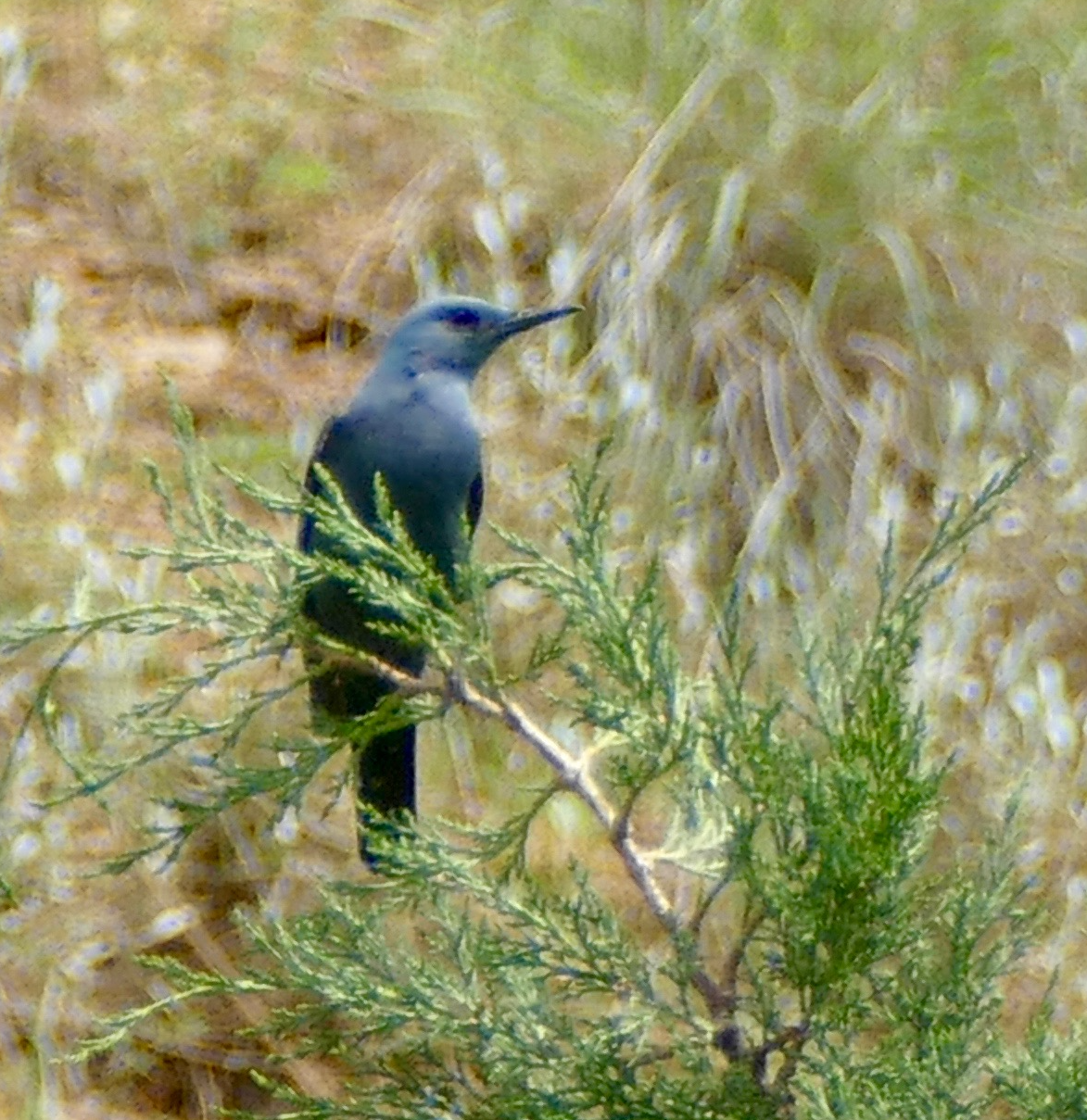
Male Blue Rock Thrush (B. Koop)
- Garden Warbler, Sylvia borin: Scarce breeder along River Vedi in broad-leaved trees.
- Common Blackcap, Sylvia atricapilla: Species of woodland in higher altitudes in Khosrov-Reserve.
- Eastern Orphean Warbler, Sylvia crassirostris: Species of bushy landscape in the same habitat as White-throated Robin. Three territories in the CWR, after one week birds were paired.
- Lesser Whitethroat, Sylvia curruca: Scarce breeder in Song is different from central European birds with a Great Tit-like phrase.
- Common Whitethroat, Sylvia communis: Common in higher altitudes in several vegetation: small bush, thickets of Anthriscus spec,. or Libanotes
- Cetti´s Warbler, Cettia cetti: Common along River Vedi.
- Marsh Warbler, Acropcephalus palustis: One singing bird 21.-22.05. near the Logde, seemed to be a passage migrant.
- Blyth´s Reed Warbler, Acrocephalus dumetorum: Vagrant, 23.05. one singing bird at River Vedie near the lodge (first: H. Roweck, confirmed at the same day: Koop). There seems to be no other record up to now, but song was typically slow with frequent repetitions.
- Great Reed Warbler, Acrocephalus arundinaceus: Common in Phragmites stands along the road to Urtzadzor, even more common in the fish ponds near Artash.
- Sedge Warbler, Acrocephalus schoenobaenus: In Phragmites in higher altitudes in Khosrov-Reserve.
- Upcher´s Warbler, Hippolais languida: Scarce, one singing male 22.05. – 24.05. in CWR.
- Eastern Olivacous Warbler, Iduna pallida: Typical species of grazed bushy areas, distance between two territories: 150 m and 200 m in CWR, but following Burfield & van Bommel (2004) rare in Armenia (300-800 pairs).
- Willow Warbler, Phylloscopus trochilus: one sighting, Passage migrant.
- Caucasian Chiffchaff, Phylloscopus lorenzii: Endemic breeding species, in wooded habitats. On a short transect in Khosrov reserve density of territories was similar to Central European Chiffchaff.
- Siberian Chiffchaff, Phylloscopus tristis: Passage migrant, 20.05. to 23.05. 1 bird in a willow bush at the lodge.
- Green Warbler, Phylloscopus nitidus: Endemic Woodland species, only once in a small oak wood in Khosrov reserve.
- Wren, Troglodytes troglodytes: Woodland species, only in Khosrov reserve.
- Spotted Flycatcher, Muscicapa striata: Woodland species, only in Khosrov reserve, in Armenia quite rare (800-1.300 pairs, Burfield & van Bommel 2004).
- Great Tit, Parus major: Woodland species, mostly in Khosrov reserve.
- Blue Tit, Cyanistes caeruleus: Woodland species, only in Khosrov reserve.
- Long-tailed Tit, Aegithalos caudatus: Woodland species, only in Khosrov reserve.
- Eurasian Nuthatch, Sitta europaea: Woodland species, only in Khosrov reserve.
- Western Rock Nuthatch, Sitta neumayer: In rocky areas with some trees or bushes above 1.000 m.
- Eastern Rock Nuthatch, Sitta tephronata: In rocky areas with some trees or bushes above 1.000 m. In CWR both species occur in small numbers, but Eastern Rock Nuthatch ist more common. Total population of Armenia: 1.500-2.300 pairs (Burfield & van Bommel 2004).
Lesser Grey Shrike, Lanius minor: Common breeder in CWR and Khosrov Reserve and very common in open cultivated Landscape around Urtzadzor. Along roads with power lines all 600 – 1.000 m one pair, locally 200-300 m one pair. Armenia is one of the strongholds, and density ist typical fort eh species in optimal habitats.
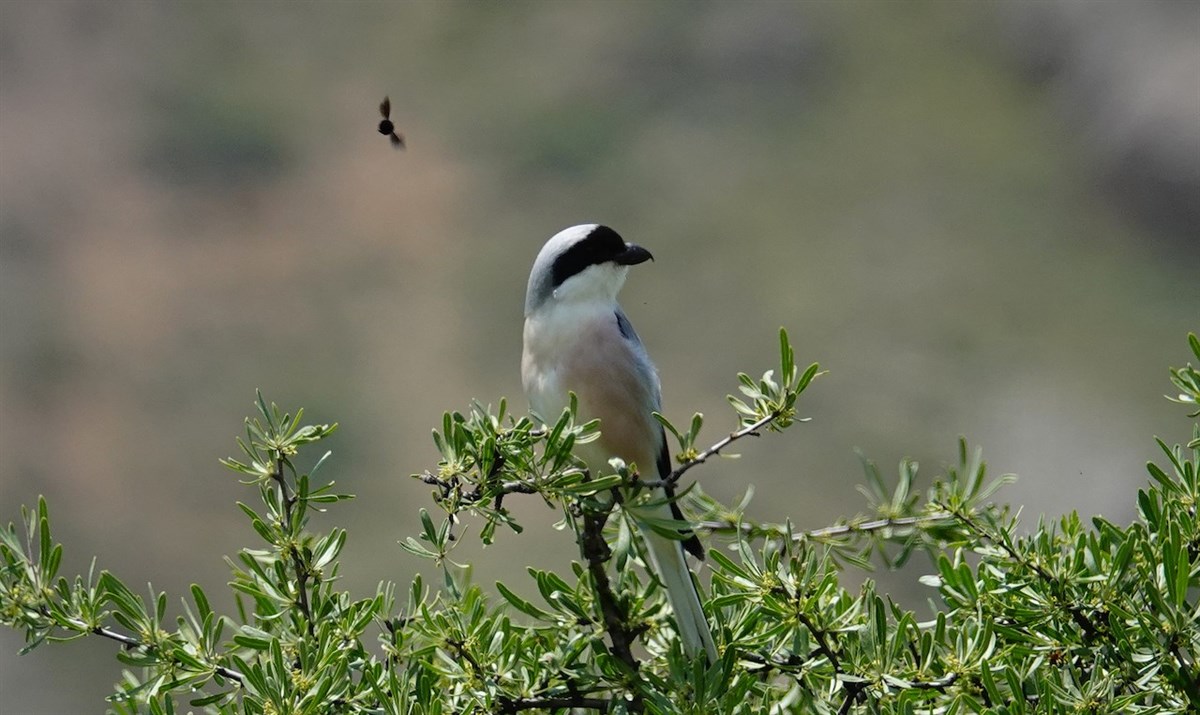
Male Lesser Grey Shrike at the Logde (H. Thiessen)
- Woodchat Shrike, Lanius senator: 3 pairs around CWR and lodge in higher altitudes (> 1.300m), seems to prefer Juniper trees and prefers higher altitudes than L. minor, but less high than L. collurio. It is nowadays a rare species in Armenia (Burfield & van Bommel 2004).
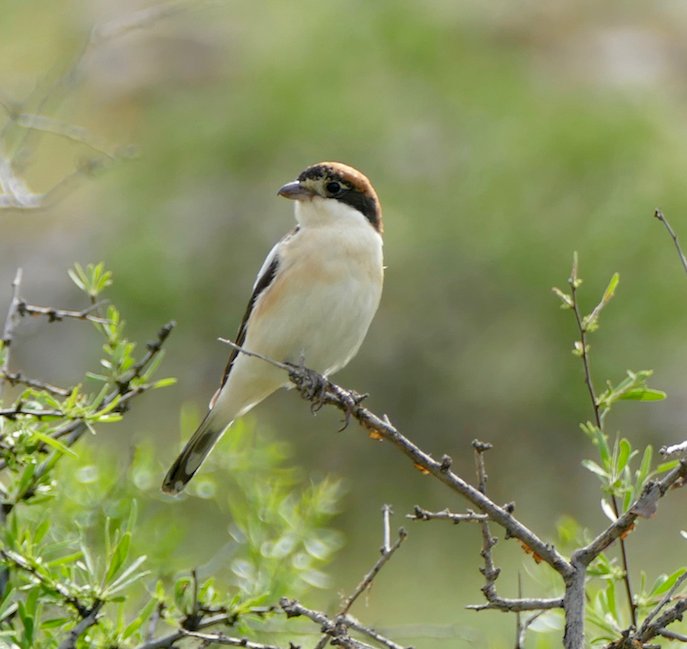
Woodchat Shrike in the CWR (B. Koop)
- Red-backed Shrike, Lanius collurio: Common in higer altitudes (> 1.500m), but scarce in cultivated landscape where Lanius minor is living. We saw no differences in habitat choice, only differences in altitude like in Glutz & Bauer (1993) described.
- Magpie, Pica pica: Very common in cultivated landscape in villages and other settlements. The birds seem to be very lon tailed.
- Eurasian Jay, Garrulus glandarius: Woodland species, mostly in Khosrov reserve. Most birds more dark capped than Central European birds.
- Hooded Crow, Corvus cornix: Common in cultivated landscape. Birds are very light grey and black.
- Common Raven, Corvus corax: 3-4 pairs in CWR.
- Jackdaw, Corvus monedula: in cultivated landscape and old buildings, copmmon in the lowlands (Artash, Ararat).
- Red-billed Chough, Pyrrhocorax pyrrhocorax: Species of rocky mountains with open grassland. At three cliffs around the logde 2+2+4 pairs.
- Common Starling, Sturnus vulgaris: Scarce in villages and cultivated landscape
- Rosy Starling, Sturnus roseus: In our time daily passage occurs to western direction, regularly following the Vedi-valley, in some days hundreds of adult birds, but not young Rosy Starlings.
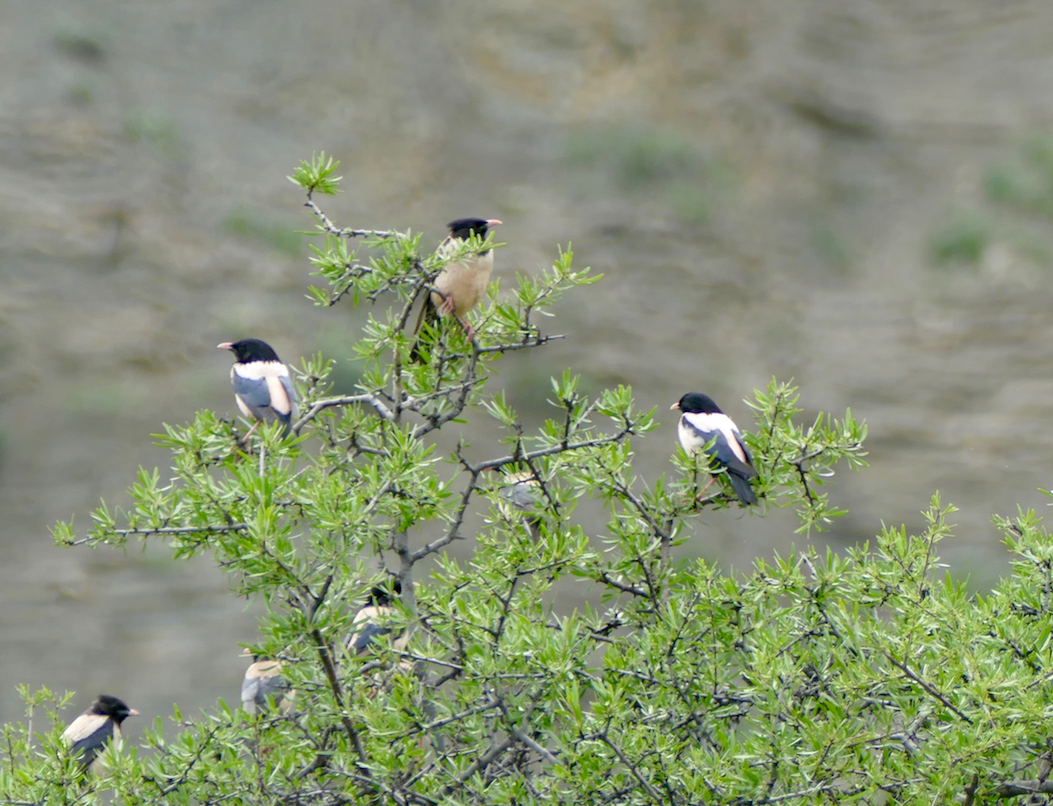
Rosy Starlings roosting on passage (B. Koop)
- Golden Oriole, Oriolus oriolus: Common near rivers with broad-leaved woodland, but following Burfield & van Bommel (2004) quite rare in Armenia with 1.000-1.500 males.
- House Sparrow, Passer domesticus: Common in all settlements.
- Tree Sparrow, Passer montanus: only a few sigthings in open woodland, especially the valley of River Vedi.
- Chaffinch, Fingilla coelebs: Woodland species, mostly in Khosrov reserve.
- Linnet, Acanthis cannabina: Common in cultivated landscape.
- Twite, Acanthis flavirostris: mountain species in higher altitudes (> 2.000 m).
- Goldfinch, Carduelis carduelis: Common in cultivated landscape.
- Greenfinch, Cardueilis chloris: Only one record in the CWR.
- Red-fronted Serin, Serinus pusillus: typical mountain species, but one of the two sightings occur in cultivated landscape near the lodge, feeding on grass seeds.
- Hawfinch, Coccothraustes coccothraustes: Only one bird flying over the Lodge.
- Common Rosefinch, Carpodacus erythrinus: Common in river valleys. Birds seem to have arrived in the breeding grounds around mid May: At first flocks up to fifteen birds feeding in the lodge area, in the end of our tour several territories were established near River Vedi.
- Ortolan Bunting, Emberiza hortulana: Only one bird at high altitudes (2.400 m) in open alpine grass land.
- Grey-nacked Bunting, Emberiza buchnani: One singing male near the lodge (8 km north) in rocky grazed landscape with small bushes, together with Western Rock Nuthatch and Kurdistan Wheatear. Species is quite rare in Armenia: 300-600 males (Burfield & van Bommel 2004).
- Black-headed Bunting, Emberiza melanocephala: This species and it´s song is most characteristic for the landscape. In cultivated landscape very common, together with Corn Bunting, often one singing male per 150-200 m. In mountain areas, f.e. around the lodge, the species is very common, neighboured pairs after 70-80 m in all directions, density exceed 10 territories per 10 hectares (13.3 territories per 10 hectares). In higher altitudes scarce.
- Birds seem to have occured some days before: In the first two days only males were seen, after 7 days the first nest building and in the last two days alarm calls occur when passing a territory.
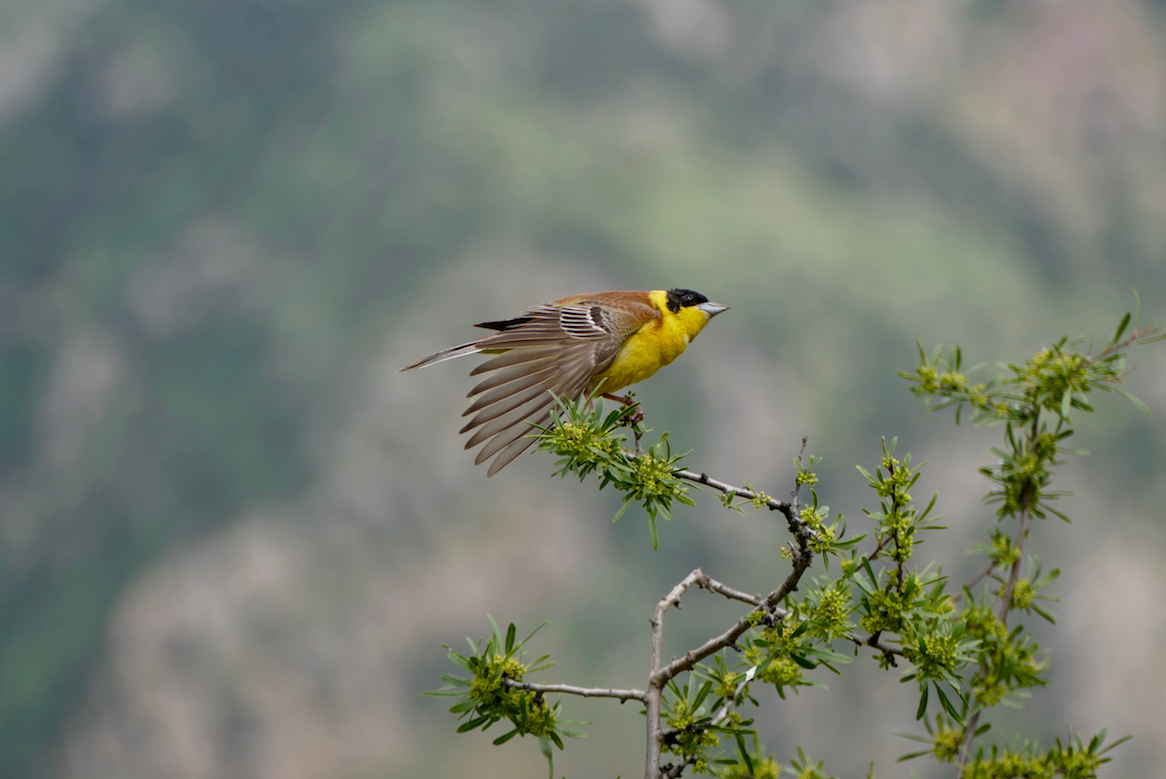
Black-headed Bunting (B. Koop)
In Glutz von Blotzheim & Bauer (1997) the species is described as common in mountain areas of Armenia with breeding densities up to 13.7 territories per 10 hectares and nest distances of around 70 m – exactly the same details we found!
- Rock Bunting, Emberiza cia: Common in higher altitudes (>1.200 m), often in Juniper trees. Territory density: 3 singing males at one transect of 2 km. This density is typical fort he species (Glutz von Blotzheim & Bauer (1997).
- Corn Bunting, Emberiza calandra: very common in cultivated landscape. Along road sides with power lines all 300 m one singing male.
Species of the surrounding landscape
- Crested Grebe, Podiceps cristatus: Breeding species of the Fishponds at Artash, 2 pairs
- White Stork, Ciconia ciconia: Common in cultivated landscape, next breeding pairs in Urtzadzor, sometimes feeding near the lodge. In the Araxat Valley 46 nests in the village of Armash
Levant´s Sparrowhawk, Accipiter brevipes: Lowland breedings species.

Levant´s Sparrowhawk, fish ponds of Artash (H. Thiessen)
- Grey Heron, Ardea cinerea: Breeding species of the Fishponds at Artash.
- Purple Heron, Areda purpurea: Breeding species of the Fishponds at Artash.
- Night Heron, Nycticorax nycticorax: Breeding species of the Fishponds at Artash.
- Little Egret, Egretta garzetta: Breeding species of the Fishponds at Artash.
- Squacco Heron, Ardeola ralloides: Breeding species of the Fishponds at Artash.
- Pygmy Cormorant, Phalcrocorax pygmaeus: Breeding species of the Fishponds at Artash.
- Glossy Ibis, Plegadis falcinellus: Breeding species of the Fishponds at Artash.
- Spoonbill, Platalea leucordia: Breeding species of the Fishponds at Artash
- Mallard, Anas platyhrhynchos: Breeding species of the Fishponds at Artash.
- Red-crested Pochard, Netta rufina: Breeding species of the Fishponds at Artash.
- Common Coot, Fulica atra: Breeding species of the Fishponds at Artash: 9 breeding pairs at three ponds.
- Common Morhen, Gallinula chloropus: Breeding species of the Fishponds at Artash.
- Black-winged Stilt, Himantopus himantopus: Breeding species of the Fishponds at Artash.
- Collared Pratincole, Glareola pratincola: Breeding species of the Fishponds at Artash. In Armenia rare: 10-30 pairs (Burfield & van Bommel 2004).
- Little Ringed Plover, Charadrius dubius: Breeding species of the Fishponds at Artash: Some ponds dried out.
- Lapwing, Vanellus vanellus: Breeding species of the Fishponds at Artash
- Common Redshank, Tringa totanus: Breeding sopecies in wet meadows of the Fishponds at Artash.
- Armenian Gull, Larus armenicus: Endemic breeding species in Armenia (10.000-12.000 pairs, (Burfield & van Bommel 2004 ), in the fish ponds near Artash a few pairs, but most birds were immature individuals.
- Gull-billed Tern, Gelochelidon nilotica: Breeding species of the Fishponds at Artash. In Armenia only 20-80 pairs occur (Burfield & van Bommel 2004).
- Common Tern, Sterna hirundo: Breeding species of the Fishponds at Artash.
- Black Tern, Chlidonias niger: Breeding species of the Fishponds at Artash.
Blue-cheeked Bee-Eater, Merops persicus: One bird seen at the fishponds of Artash. In Armenia very rare: 3-5 pairs (Burfield & van Bommel 2004).
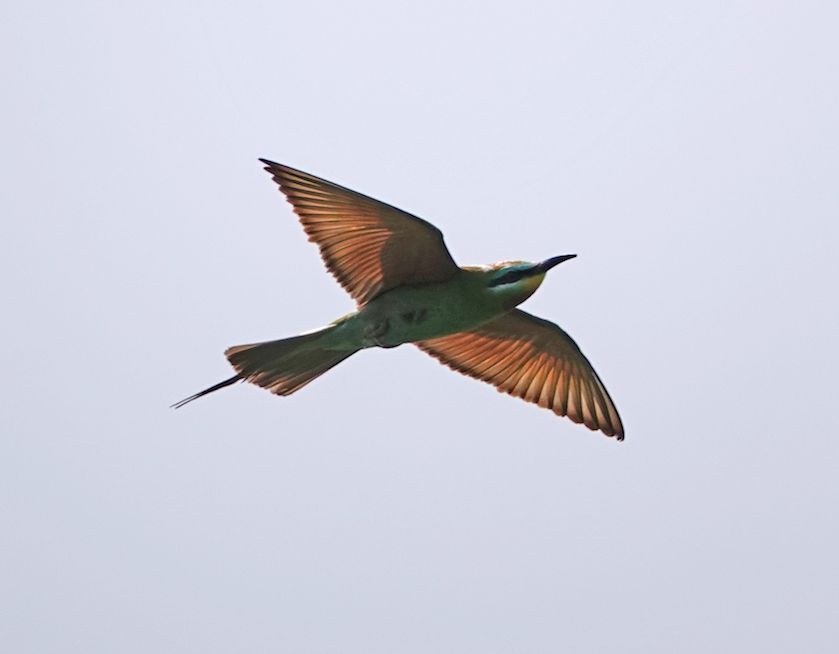
Blue-cheeked Bee-eater (H. Thiessen)
- Syrian Woodpecker, Dendrocopos syriacus: 1 near Ararat in the lowlands.
- Common Reedwarbler, Acrocephalus scirpaceus: Breeding species of the Fishponds at Artash, less common than Great Reedwarbler an Paddyfield Warbler.
- Paddyfield Warbler, Acrocephalus agricola: Breeding species of the Fishponds at Artash. 3 singing males together with Reedwarbler. In Armenia scarce (50-250 pairs, Burfield & van Bommel 204), seems to be restricted to this restricted habitat.
- Southern Yellow Wagtail, Motacilla feldegg: Breeding species of the Fishponds at Artash.
- Reed Bunting, Emberiza schoeniclus: Breeding species of the Fishponds at Artash.
- Armenia has 192 breeding species (Heath & Evans 2000) with a focus on alpine species, raptors and stepp epecies.Some confusion exists about the bigger falcons: Following Burfield & van Bommel (2004) Falco cherrug does not breed, but Falco biarmicus breed (20-30 pairs).Some species of the region we we didn´t see, perhaps time was too short. Especially early breeding species wie didn´t found (Tetraogallus caspicus, Turdus torquatus), and alpine species for which wie have had to get up in higher regions. Some breeding species of the CWR and the Khosrov-Reserve we haven´t seen: Neophron percnopterus, Falco naumanni, Tetraogallus caspicus, Dryocopus martius, Eremophila alpestris, Petronia petronia or Rhodopechys sanguineus.The visit of the fishponds was too short, only at midday and only on the edge with no entrance. So we missed waterfowl species like Anser anser,Tadorna ferruginea, Aythya nyroca, Marmoretta angustrirostris or Oxyura leucocephala, which all breed there.
References:
Burfield, I. & F. van Bommel (2004): Birds in Europe. BirdLife Conservation Series No 12; BirdLife International, Wageningen.
Glutz von Blotzheim & Bauer (1985): Handbuch der Vögel Mitteleeuropas, Bd. 10/II. Aula. Wiesbaden.
Glutz von Blotzheim & Bauer (1993): Handbuch der Vögel Mitteleeuropas, Bd. 13/II. Aula. Wiesbaden.
Glutz von Blotzheim & Bauer (1997): Handbuch der Vögel Mitteleeuropas, Bd. 14/III. Aula. Wiesbaden.
Heath, M. F. & M. I. Evans (2000): Important Bird Areas in Europe, Vol. 2, Southern Europe. BirdLife Conservation Series No 8; BirdLife International, Wageningen.

